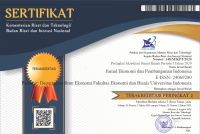Abstract
Inequality occurs in the process of economic development along with di erences in the natural resources and infrastructure owned by each region. Income inequality reduction programs require accurate data collection and have to reach the smallest areas. This study discusses the application of the Elbers, Lanjouw, and Lanjouw (ELL) and Counterfactual methods to obtain estimates of income inequality indicators at the sub-district and village levels in the Kota Yogyakarta and map them in the form of a poverty map. The data used are Population Census 2010, SUSENAS (2010 and 2018), PODES (2011 and 2018), as well as other BPS publications. The results showed that the estimator of income inequality using the ELL method has a smaller RSE value than the direct estimation results. Poverty Map presents a snap-shot of the distribution of the level of inequality in a relatively heterogeneous small area.
Bahasa Abstract
Ketimpangan terjadi dalam proses pembangunan ekonomi seiring dengan adanya perbedaan sumber daya alam dan infrastruktur yang dimiliki oleh masing-masing daerah. Program penanggulangan ketimpangan pendapatan memerlukan pendataan yang akurat dan menjangkau sampai wilayah terkecil. Penelitian ini membahas penerapan metode Elbers, Lanjouw, dan Lanjouw (ELL) dan Counterfactual untuk mendapatkan estimasi indikator ketimpangan pendapatan pada level kecamatan maupun desa/kelurahan di Kota Yogyakarta serta memetakannya dalam bentuk poverty map. Data yang digunakan adalah Sensus Penduduk (SP2010), SUSENAS (2010 dan 2018), PODES (2011 dan 2018), serta publikasi BPS lainnya. Hasil penelitian menunjukkan bahwa penduga ukuran ketimpangan pendapatan dengan metode ELL memiliki nilai RSE yang lebih kecil dibandingkan dengan hasil pendugaan langsung. Poverty Map menampilkan snap-shot distribusi tingkat ketimpangan pada area kecil yang relatif heterogen.
References
- Agusalim, L. (2016). Pertumbuhan ekonomi, ketimpangan pedapatan dan desentralisasi di Indonesia. Kinerja, 20(1), 53-68. doi: https://doi.org/10.24002/kinerja.v20i1.697.
- Betti, G., Dabalen, A., Ferré, C., & Neri, L. (2013). Updating poverty maps between Censuses: a case study of Albania. In Ruggeri Laderchi, C., & Savastano, S. (eds), Poverty and exclusion in the Western Balkans [Economic studies in inequality, social exclusion and well-being, volume 8], (pp. 55-70). Springer. doi: https://doi.org/10.1007/978-1-4614-4945-4_5.
- BPS. (2018). SUSENAS (Survei sosial ekonomi nasional) 2018, pedoman II.A, pedoman pencacah kor. Badan Pusat Statistik. Diakses 23 September 2019 dari https://www.rand.org/content/dam/rand/www/external/labor/ bps/manualpdf/susenas/ssn98pedomanpencacahk.pdf.
- BPS. (2020). Tabel dinamis Gini ratio provinsi 2022– 2020. Badan Pusat Statistik. Diakses 20 Juli 2020 dari https://www.bps.go.id/dynamictable/2017/04/26%2000: 00:00/1116/gini-ratio-provinsi-2002-2018.html.
- BPS Provinsi D.I. Yogyakarta. (2019). Statistik kemiskinan Daerah Istimewa Yogyakarta 2019. Badan Pusat Statistik Provinsi Daerah Istimewa Yogyakarta.
- Elbers, C., Lanjouw, J. O., & Lanjouw, P. (2003). Micro-level estimation of poverty and inequality. Econometrica, 71(1), 355-364. http://www.jstor.org/stable/3082050.
- Fujii, T. (2005). Micro-level estimation of child malnutrition indicators and its application in Cambodia. Policy Research Working Paper, 3662. World Bank. Diakses 23 September 2019 dari https://openknowledge.worldbank.org/handle/ 10986/8206.
- Ganie-Rochman, M. (2013, Januari 29). Disparitas pendapatan. Kompas.
- Guadarrama, M., Molina, I., & Rao, J. N. K. (2016). A comparison of small area estimation methods for poverty mapping. Statistics in Transition New Series, 1(17), 41-66. doi: https://doi.org/10.21307/stattrans-2016-005.
- Henninger, N., & Snel, M. (2002). Where are the poor? Experiences with the development and use of poverty maps. World Resources Institute and UNEP/GRID-Arendal. Diakses 23 September 2019 dari https://www.wri.org/research/ where-are-poor-experiences-development-and-usepoverty-maps.
- IFAD. (2013). Inventori sumberdaya pesisir Pulau Lembeh. Laporan akhir. Manado: International Fund for Agricultural Development.
- jogja.idntimes.com. (2019, 18 Juli). Jurus Pemerintah Yogyakarta Turunkan Angka Ketimpangan Sosial. Diakses 1 Agustus 2020 dari https: //jogja.idntimes.com/business/economy/holy-kartika/jurus-pemerintah-yogyakarta-turunkan-angkaketimpangan-sosial.
- Kompas.com. (2011, 8 Februari). Kesenjangan ekonomi semakin lebar. Diakses 18 Juli 2020 dari https://bola.kompas.com/read/2011/02/08/07152538/ kesenjangan.ekonomi.semakin.lebar?page=1.
- Longford, N. T. (2005). Missing data and small-area estimation: modern analytical equipment for the survey statistician. Springer Science+Business Media, Inc.
- Prasad, N. N., & Rao, J. N. (1990). The estimation of the mean squared error of small-area estimators. Journal of the American Statistical Association, 85(409), 163-171.
- Putri, Y. E., Amar, S., & Aimon, H. (2015). Analisis faktor-faktor yang mempengaruhi pertumbuhan ekonomi dan ketimpangan pendapatan di Indonesia. Jurnal Kajian Ekonomi, 3(6).
- Rao, J. N. K. (2003). Small area estimation. Wiley-Interscience.
- Rascon-Ramirez, E. G., & Scott, K. (2015). Nutrition mapping in Mexico. Unpublished report. The World Bank Group.
- Rogers, B. L., Wirth, J., Macías, K., Wilde, P., & Friedman, D. (2007). Mapping hunger: a report on mapping malnutrition prevalence in the Dominican Republic, Ecuador and Panama. World Food Programme, Office for Latin America and the Caribbean & the Friedman School of Nutrition Science and Policy, Tufts University. Diakses 23 September 2019 dari https://nutrition.tufts.edu/sites/default/files/fpan/ HungerMappingSynthesisReport.pdf.
- Saleh, K. (2009). Analisis komprehensif hasil survei MDGs kecamatan: MDGs Millennium Development Goals seri 12. Badan Pusat Statistik & UNICEF.
- Simler, K. R. (2006). Nutrition mapping in Tanzania: an exploratory analysis. FCND Discussion Paper, 204. International Food Policy Research Institute, Food Consumption and Nutrition Division. Diakses 23 September 2019 dari https: //www.ifpri.org/publication/nutrition-mapping-tanzania.
- SMERU. (2008). Peta kemiskinan Indonesia: asal mula dan signifikansinya = The poverty map of Indonesia: genesis and significance. Newsletter SMERU, 26: May-Aug/2008. Diakses 23 September 2019 dari https://www.smeru.or.id/ sites/default/files/publication/news26.pdf.
- World Bank. (2015). Ketimpangan yang semakin lebar: ringkasan eksekutif. Diakses 23 September 2019 dari https://thedocs.worldbank.org/ en/doc/675081449485078675-0070022015/render/ ExecutiveSummaryIndonesiasRisingDivideBhsIndonesia. pdf.
Recommended Citation
Widyawati, Dewi and Muchlisoh, Siti
(2022)
"Poverty Map sebagai Potret Ketimpangan Pendapatan Area Kecil di Kota Yogyakarta,"
Jurnal Ekonomi dan Pembangunan Indonesia: Vol. 22:
No.
2, Article 2.
DOI: 10.21002/jepi.2022.10
Available at:
https://scholarhub.ui.ac.id/jepi/vol22/iss2/2







